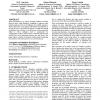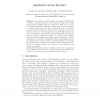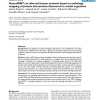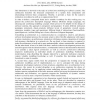662 search results - page 91 / 133 » Formalizing Basic First Order Model Theory |
EICS
2009
ACM
14 years 3 months ago
2009
ACM
Smart environments (e.g., airports, hospitals, stadiums, and other physical spaces using ubiquitous computing to empower many mobile people) provide novel challenges for usability...
ICFEM
2009
Springer
14 years 3 months ago
2009
Springer
An extension to action systems is presented facilitating the modeling of continuous behavior in the discrete domain. The original action system formalism has been developed by Back...
BMCBI
2005
13 years 8 months ago
2005
Background: The application of high throughput approaches to the identification of protein interactions has offered for the first time a glimpse of the global interactome of some ...
AOSE
2005
Springer
14 years 2 months ago
2005
Springer
In order to create adaptive Agent Systems with abilities matching those of their biological counterparts, a natural approach is to incorporate classical conditioning mechanisms int...
BIRTHDAY
2010
Springer
13 years 7 months ago
2010
Springer
m, modules, types and operations), different kinds of abstractions (functional/data, types/objects etc.) without falling into a loose collection of diagram languages. Considering a...




